Read Time: 6 Minutes Subscribe & Share
Just The Facts
Let’s get one thing straight. Making my own mayonnaise is a given, but, I am not ever going to make my own barbecue sauce. I (being From The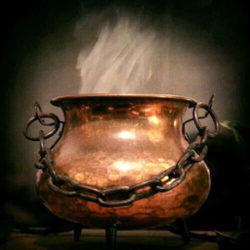 North) was not brought up with it and actually neither was the person From The South who resides with me. But he did start eating barbecue this and barbecue that during the happy almost-decade he spent at UVA. He loved the school and he loved barbecue. After a few taste misfires, I have actually come to like some versions of it. In the shop, we had requests from both local and international clients who wanted to take a good example back home, so we launched a search for really good and unique barbecue sauces.
North) was not brought up with it and actually neither was the person From The South who resides with me. But he did start eating barbecue this and barbecue that during the happy almost-decade he spent at UVA. He loved the school and he loved barbecue. After a few taste misfires, I have actually come to like some versions of it. In the shop, we had requests from both local and international clients who wanted to take a good example back home, so we launched a search for really good and unique barbecue sauces.
 This repeated request required numerous treks down the aisles of the Fancy Food Show. Not that we minded, as we often found some real gems hidden away from the super hyped big marketing venues. Countries will buy space in the NASFT foodapaloozas, and so will states. Usually the country aisles are hugely lacking in American marketing come-hither expertise, but we did find over the years some unique small producers who became beloved by La Cuisine shoppers. Interestingly, in the state-supported aisles, you saw very clever homegrown marketing and action – story telling, engaged producers, clever tastings – and, really for the Cuisinettes, it all came down to the taste.
This repeated request required numerous treks down the aisles of the Fancy Food Show. Not that we minded, as we often found some real gems hidden away from the super hyped big marketing venues. Countries will buy space in the NASFT foodapaloozas, and so will states. Usually the country aisles are hugely lacking in American marketing come-hither expertise, but we did find over the years some unique small producers who became beloved by La Cuisine shoppers. Interestingly, in the state-supported aisles, you saw very clever homegrown marketing and action – story telling, engaged producers, clever tastings – and, really for the Cuisinettes, it all came down to the taste.
So, after a few years of sampling detestable barbecue sauces, overloaded with tomato concentrate, truly low-end spices, corn syrup, plus a surprising amount of chemical additives (some parading as liquid smoke), we hit the jackpot. We located products concocted by two UVA grads who made outstanding examples of that very particular American southern specialty – Barbecue Sauce and a masterful Dry Rub.
A Tangled History
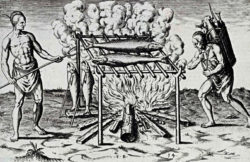 It is astonishing to note that there are currently over 7000 producers of barbecue sauce, and its complex history probably has the same number of roots. Our current word “Barbecue” most likely comes from a Spanish corruption of the native term for the slow cooking process over a frame – not to be confused with grilling- used by the indigenous tribes in the Caribbean Islands (notably the Taino, who were enslaved and their population decimated by the landing of Columbus at the end of the 15th century) and also by southeastern Indian tribes in what is now the USA. These were all noted in diaries by Spanish, French and English explorers in the New World from the 16th century onward. The introduction of feral pigs to this process was introduced by the Spanish colonizers. But as a method of
It is astonishing to note that there are currently over 7000 producers of barbecue sauce, and its complex history probably has the same number of roots. Our current word “Barbecue” most likely comes from a Spanish corruption of the native term for the slow cooking process over a frame – not to be confused with grilling- used by the indigenous tribes in the Caribbean Islands (notably the Taino, who were enslaved and their population decimated by the landing of Columbus at the end of the 15th century) and also by southeastern Indian tribes in what is now the USA. These were all noted in diaries by Spanish, French and English explorers in the New World from the 16th century onward. The introduction of feral pigs to this process was introduced by the Spanish colonizers. But as a method of 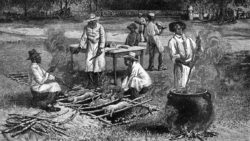 cooking, it travelled by the numerous migrant populations as far west as the Kansas and Texas territories, and of course through the Carolinas and Virginia. George Washington wrote in his diary about a barbecue party he hosted. Websites abound with histories of barbecue, but it is clear that the addition of citrus and spices and chilies came from the people enslaved and sent to the fields in the colonial New World. Lime or other sharp flavored citrus was replaced with vinegar by Scottish and English settlers in the southeastern colonies of the US thanks to the lack of access to these fruits. The addition of mustard to some versions reveals the stream of German immigrants who adapted the recipe to their tastes from the homeland. Tomatoes were a relatively newfangled addition to barbecue sauces and were not really noted until the early 20th century. But the idea of slow smoking over a frame with whatever protein you had on hand remained with streams of settlers in the 19th century, and each group brought its own twist to the way barbecue is done
cooking, it travelled by the numerous migrant populations as far west as the Kansas and Texas territories, and of course through the Carolinas and Virginia. George Washington wrote in his diary about a barbecue party he hosted. Websites abound with histories of barbecue, but it is clear that the addition of citrus and spices and chilies came from the people enslaved and sent to the fields in the colonial New World. Lime or other sharp flavored citrus was replaced with vinegar by Scottish and English settlers in the southeastern colonies of the US thanks to the lack of access to these fruits. The addition of mustard to some versions reveals the stream of German immigrants who adapted the recipe to their tastes from the homeland. Tomatoes were a relatively newfangled addition to barbecue sauces and were not really noted until the early 20th century. But the idea of slow smoking over a frame with whatever protein you had on hand remained with streams of settlers in the 19th century, and each group brought its own twist to the way barbecue is done
Sawbones Become Sauce Makers
As the labels hint, Bruce and David met as chief resident and new faculty member at the University Of Virginia’s Department of Orthopaedic Surgery in Charlottesville, Virginia. They became friends, sharing a not-so-medical interest – cooking. David bought a smoker, fiddled with a neighbor’s recipe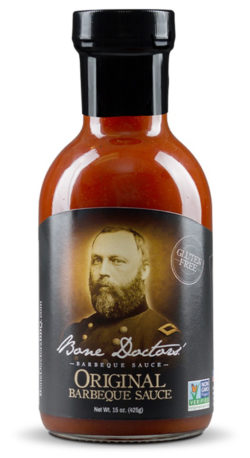 for a basting sauce and shared it with Bruce. Both married, had children and continued to tweak versions of what now was “their” barbecue sauce. A daughter’s soccer game at a venue that had no food in sight, gave David the idea to bring his own delicious BBQ sandwiches and use the sale of said sandwiches as a fundraiser for the daughter’s team. There was so much demand for the sandwiches (bathed with the now famous sauce) that the two surgeons had to massively increase production for each game. And ultimately, sales brought enough revenue to send the soccer team to Europe! Meanwhile one of Bruce’s patients had his own recipe for the vinegar-based sauce that is particular to eastern North Carolina, and the BBQ wheels in the surgeons’ brains started turning
for a basting sauce and shared it with Bruce. Both married, had children and continued to tweak versions of what now was “their” barbecue sauce. A daughter’s soccer game at a venue that had no food in sight, gave David the idea to bring his own delicious BBQ sandwiches and use the sale of said sandwiches as a fundraiser for the daughter’s team. There was so much demand for the sandwiches (bathed with the now famous sauce) that the two surgeons had to massively increase production for each game. And ultimately, sales brought enough revenue to send the soccer team to Europe! Meanwhile one of Bruce’s patients had his own recipe for the vinegar-based sauce that is particular to eastern North Carolina, and the BBQ wheels in the surgeons’ brains started turning
Taking their Original Sauce and (to my mind, much improved) North Carolina vinegar version, they developed a small company to market a non-GMO, non-artificially flavored group of sauces. Their first thought was to sell at local farmers’ markets and stores – Charlottesville has always been a hotbed of good food producers, restaurants and gourmet retailers. The financial goal was to have enough money to take their families on annual vacations. That changed dramatically the year we came across them at the Fancy Food Show. When we first were knocked out by their line sauces (and rub) they received the prestigious SOFI award at the Fancy Food Show in 2011. And now they ship to Canada, Costa Rica and Germany. I can never make up my mind which is my favorite, so I have them all.
Bone Doctors’ Rundown
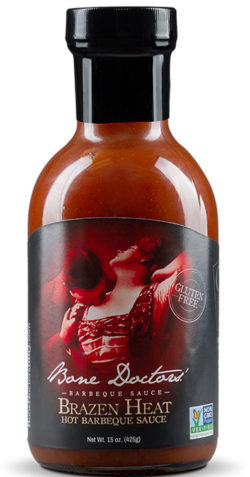 I don’t know how they picked the photos to use on their labels, something I normally and studiously ignore when choosing
I don’t know how they picked the photos to use on their labels, something I normally and studiously ignore when choosing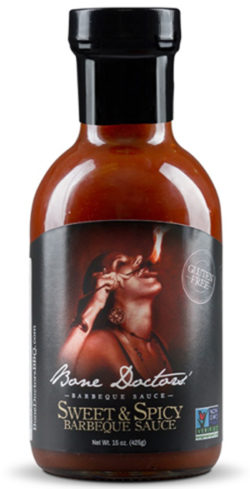 products, but they are priceless. As Bruce said in an email, there is reason why Facebook is called “Facebook”.
products, but they are priceless. As Bruce said in an email, there is reason why Facebook is called “Facebook”. 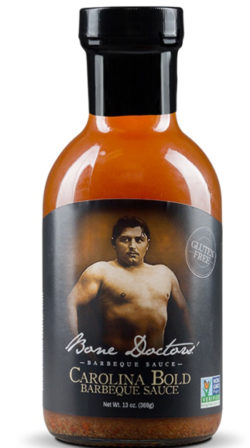 Sweet and Spicy was Larissa’s favorite when we had tastings in the shop. It is a great addition to a traditional Boston Baked Bean recipes (I actually thought it made it sooooo much better). There is a nectarine and peach salad (you grill the peaches with it and just add a bit to the dressing). It was an experiment that the good doctors devised
Sweet and Spicy was Larissa’s favorite when we had tastings in the shop. It is a great addition to a traditional Boston Baked Bean recipes (I actually thought it made it sooooo much better). There is a nectarine and peach salad (you grill the peaches with it and just add a bit to the dressing). It was an experiment that the good doctors devised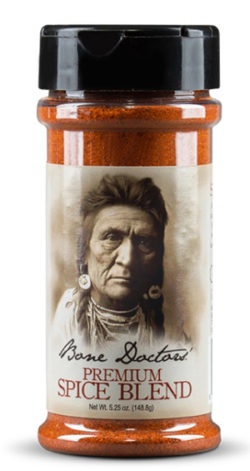 with local peaches and honey and cranberry juice.
with local peaches and honey and cranberry juice.

Kitchen Detail shares under the radar recipes, explores the art of cooking, the stories behind food, and the tools that bring it all together, while uncovering the social, political, and environmental truths that shape our culinary world.




Love your articles. Still miss you all. Please come back ! Okay, the article does help fill the void….but OT will never be the same.
Hi Marilyn,
Wonderful to hear from you and also that you love the articles we produce. We are still researching good sources for KD readers so there is more to come. And I miss seeing faces in the shop too.
Nancy